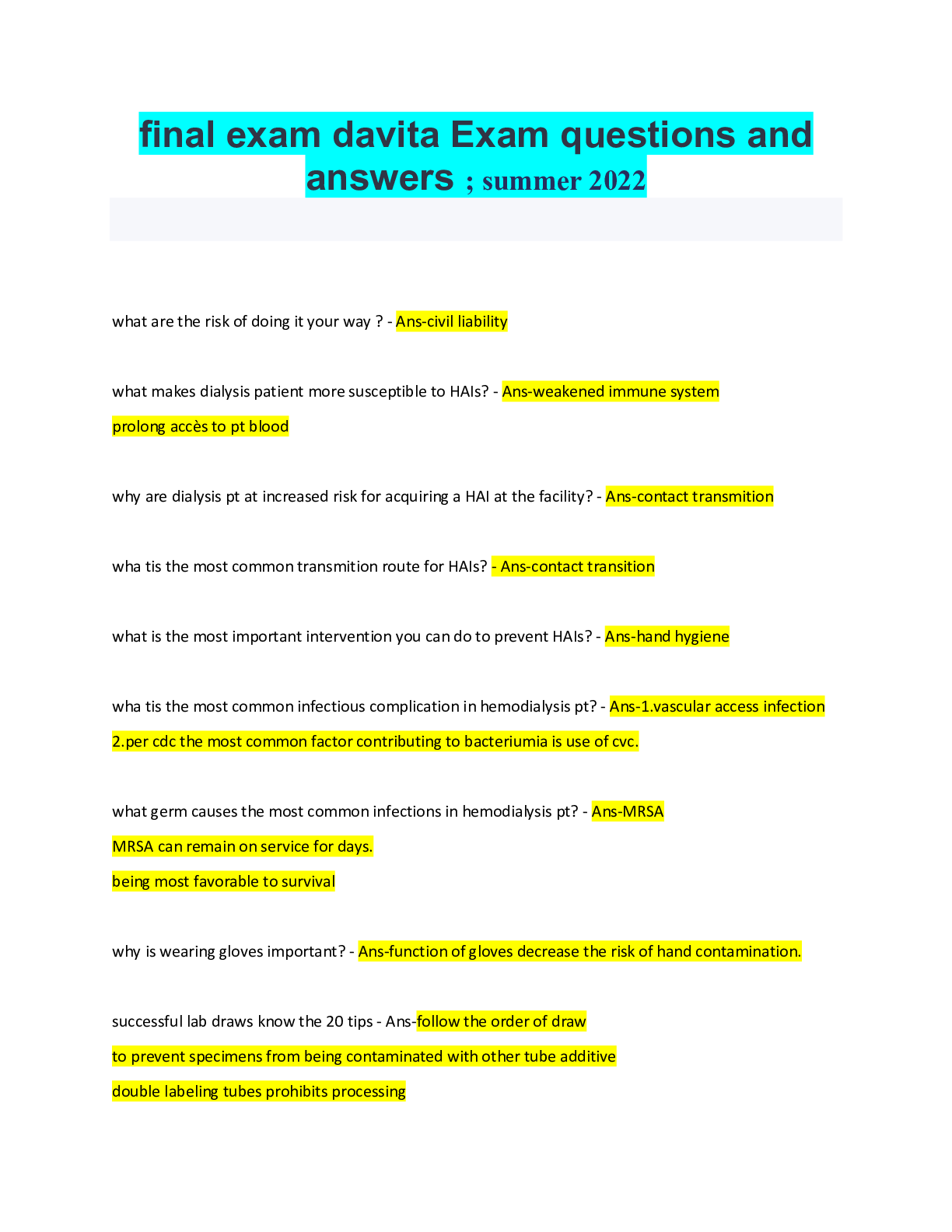*NURSING > Test Prep > Nur 112 Final (pediatrics, ob./maternity Med surge, test 1,2,3,4)updated 2022/2023 (All)
Nur 112 Final (pediatrics, ob./maternity Med surge, test 1,2,3,4)updated 2022/2023
Document Content and Description Below
Safety & Protection from Infection Injury Prevention •Unintentional injury is the leading cause of death in children ages 1- 21 •Infants o Suffocation o MVA o Drowning •Children o MVA o ... Drowning o Fires/burns Injury Prevention: Infants •Proper use of car seats •Proper crib practices •Aspiration •Burns •Suffocation/drowning •Falls •Poisoning •Bodily damage oShaken baby syndrome Injury Prevention: Toddlers & Pre-school •Proper car restraints •Motor-vehicle safety •Burns •Drowning •Accidental poisoning •Falls •Aspiration/suffocation button batteries-immediately taken out if ingested •Bodily injury o Good touch/bad touch Injury Prevention: School-age •Motor vehicle safety •Bicycle/scooter safety •Drowning •Burns •Poisoning •Bodily damage o Firearms o Trampolines o ATV o Bullying Injury Prevention: Adolescents •Motor vehicle accidents & related issues o Cell phones o Alcohol o ATVs •Firearms •Bodily damage o Sports injuries •Concussions o Bullying •Poisoning o Drugs, alcohol, medications Car Seat Recommendations Violence •Harmful behaviors that may start early and continue into young adulthood o Victim, offender or witness •Exposure to violence o Environment o TV, video games, movies •Bullying Child Maltreatment •Neglect o Physical o Emotional o Emotional abuse/psychological maltreatment •Physical abuse o Shaken baby syndrome o Munchausen Syndrome by Proxy( fabricating symptoms to make it seem like your sick using someone else) •Sexual abuse •Mandated reporters in PA o "Individuals who, in the practice of their employment, occupation or practice of a profession, come into contact with children and have reasonable cause to suspect that a child under the care, supervision, guidance, or training of that person or of an agency, institution, organization or other entity with which that person is affiliated is a victim of child abuse." Injury Prevention: Nursing Role •Education •Community awareness •Safety clinics •Family support Poison Control Center- 1-800-222-1222(parents should know) • Poisoning • Peak incidence ages 1 - 4y o Why?- They put everything in their mouth curiosity • Accidental vs. intentional o Can be fatal in adolescents • Drug abuse (alcohol ingestion) • Suicide o Abuse Posion Prevention •Keep environment safe oChild-proofing •Poison Prevention Packaging Act of 1970 oRequires certain household substances to be packaged in child-resistant packaging oPackaging must be "significantly difficult" for children under 5 to open within a reasonable time and not difficult for normal adults to use properly Acute Management of Poisoning •Gastric decontamination oGastric lavage- stomach pumping oActivated charcoal-(liquid form absorbs out comes poop) oCathartics - Make have bowel movement oIpecac (2003)- not used anymore, vomits meds back up •Specific antidotes or antagonists Common Sources of Poisoning •Hydrocarbons oGasoline, kerosene, paint thinner •Corrosives oHousehold cleaners •Medications oAcetaminophen oAspirin oIron •Plants •Cosmetics Lead Poisoning •~4 million households have children exposed to high levels of lead •500,000 children ages 1-5 with blood lead levels > 5 µg/dL •At risk o1-5 yo oLower SES oLiving in an older home •Sources of lead in the home •Lead-based paint in homes built prior to 1978 oPaint chips oDust oRenovations oSoil, pipes (Flint, Michigan; some NJ schools) •Prenatal exposure •Cultural practices •Affects renal, hematologic, neurologic systems •Interferes with normal cellular function o Binds and competes with Ca+2 function o Accumulates in soft tissue, bones and teeth o In the brain, disrupts biochemical functioning, release of neurotransmitters, alters BBB o Interferes with iron binding on heme molecules •Clinical presentation is related to degree of lead in system Long-Term Effects of Lead Poisoning • Central nervous system most affected • High level exposure (Lead encephalopathy) o Cognitive impairment o Behavior changes o Paralysis o Seizures • Moderate to low level exposure o Increased distractibility o Shortened attention span o Impulsivity o Reading disabilities/school problems Lead Levels( (9 months of age if considered to have in home for test of exposure) • Ideal o CDC goal < 5 μg/dL • 10 - 14: Education, environmental assessment, retest • 15 - 19: above + additional monitoring • 20 - 44: above + lab work, environmental investigation, lead hazard reduction, neurodevelopmental monitoring • 45 - 69: above + begin chelation therapy • ≥70: Immediate medical treatment & chelation therapy; hospitalize Chelation Therapy-(do to take heavy metals out of the body, must be taken from blood not organs) • Process of removing lead from the circulating blood; some from organs and tissues o Removal only, does not counteract effects of lead • Agents that bind with lead, enhance elimination from the body o CaNa2-EDTA (IV usually; IM)—eliminated through kidneys and urine. Potential nephrotoxicity. o Succimer (PO, sprinkles) o BAL (deep IM only, Z-track) • Given with EDTA • NOT for child with peanut allergy or G6PD deficiency • Can become toxic with iron medications • Adequate hydration • Potential toxic side effects Protection from Infection • Immunization • Common Childhood Illnesses • Fever Immune System • Innate immune system • Natural barriers o Physical o Mechanical o Biochemical • Inflammatory response • Nonspecific o Blood vessel dilation o Increased vascular permeability o Phagocytosis Acquired Immune System 1. Active immunity (specific)-vaccines • Produced by the body after natural exposure to an antigen a. Immunization • Long-lived 2. Passive immunity • Preformed antibodies or T lymphocytes are transferred from donor to recipient a. Passage of maternal antibodies across placenta to fetus b. Breastfeeding c. Immune globulin administration (rabies, hepatitis A, tetanus) • Temporary Immunization • Development of vaccines in the 20th century has contributed to a dramatic decline in child mortality from preventable communicable diseases • Prophylaxis of many (pediatric) diseases • Most are given during infancy • May have subsequent boosters • Live and inactivated products • Recommendations for immunization schedule from ACIP: Advisory Committee on Immunization Practices & AAP Committee on Infectious Diseases updated yearly Contraindications to Immunization • Severe febrile illness-fever • Live virus vaccines (varicella, MMR) o Immunocompromised children o Recent passive immunity (blood transfusion, Ig) • Known allergic response Immunization Administration • Storage most vaccines must be stored in fridge • Expiration-document • Vaccine Information Statement (VIS)-each vaccine info • Parental consent-every vacination • Oral o Rotavirus • Nasal spray o Live attenuated influenza • SQ o MMR o VAR • Fatty tissue of thigh or triceps • IM- intramuscular o Most vaccines o Usually administer 2 per site o 4 max per visit o Vastus lateralis in infants, young children o Deltoid in older children Immunization Reactions Minor • Local o At injection site • Swelling • Tenderness • Erythema • Low grade fever • Behavioral changes o Drowsiness o Irritability o Changes in appetite Severe • Seizures (febrile) • High fever • Allergic reactions Immunization Documentation • Date of administration • Site/route of administration • Manufacturer o Lot # o Expiration date • Evidence of parental/guardian consent • Adverse reactions o Vaccine Adverse Event Reporting System (VAERS) Immunization Concerns • "Vaccine-hesitant parents" • Too many shots too soon • Additives/preservatives o Thimerosal • "Natural" exposure is better • Hep B/HPV o Sex • VACCINES DO NOT CAUSE AUTISM • HPV VACCINE IS AN ANTI-CANCER VACCINE, NOT A SEX-PROMOTION VACCINE! Assessing for a Communicable Illness • Ask parents/caregivers . . . • Was there was a recent exposure to a communicable illness? o Sick contacts o Recent travel • Did prodromal symptoms exist? o Timing/onset • What is child's immunization history? Pertussis (Whooping Cough)- Vaccine not best immunity only 3 years Bordetella pertussis Three stages 1. Catarrhal • Symptoms of URI lasting 1-2 weeks, low grade fever • Then cough becomes more severe 2. Paroxysmal • Paroxysms of short, rapid cough followed by high-pitched "whoop" • Cough more common at night • Lasts 4-6 weeks 3. Convalescent • Gradual recovery • Less persistent coughs that disappear in 2-3 weeks (More D)DTaP @ 2, 4, 6 months 15-18 months, 4-6 years (More T)Tdap @ 11-12 years; pregnant women during each pregnancy, at 27-36 weeks gestation (passive immunity to baby Pertussis (Whooping Cough) Complications • Pneumonia • Apnea • Atelectasis • OM • Hemorrhage o Scleral o Conjunctival o Epistaxis • Hernia • Syncope, sleep issues, rib fractures, incontinence Nursing Care • Immunization • NP culture for diagnosis o Hospitalization o Droplet precautions- spread by droplet o Hydration o Oxygenation during episodes o Humidified O2 o Treatment = antibiotics o ≥1 month old: erythromycin, clarithromycin and/or azithromycin started prior to paroxysmal stage o Or trimethoprim-sulfamethoxazole Diphtheria & Tetanus • Cornebacterium diptheriae • Produces an exotoxin that causes o Weakness o Sore throat o Fever o Swollen glands in the neck • Pseudomembrane formed from dead tissues in 2-3 days and covers nasal tissues, tonsils, larynx, throat making breathing and swallowing difficult • The toxin can be absorbed into blood stream and cause damage to the heart, kidneys, nerves • Droplet precautions Tetanus • Clostridium tetani • Present in soil, dust and manure • Enters the body through breaks in the skin caused by contaminated objects • Produces an exotoxin that affects motor neurons/CNS o Lockjaw o Headache o Muscle spasms o Painful muscle stiffness all over the body o Trouble swallowing o Seizures o Fever and sweating o Hypertension/tachycardia • DTaP @ 2, 4, 6 months, 15-18 months, 4-6 years • Tdap @ 11-12 years Measles • Paramyxovirus; aka Rubeola • Symptoms appear about 7 - 14 days after infection • Measles typically begins with o High fever o Cough o Coryza-runny nose o Conjunctivitis • 2-3days later Koplik spots (tiny white spots) may appear inside the mouth • 3-5 days later a rash appears o Macular rash starts on the face at the hairline o Spreads downward to the neck, trunk, arms, legs, feet o May become maculopapular and confluent as spreads from face to body • Highly contagious • Lives in the nose and throat mucus of an infected person • Spreads via coughing and sneezing • Can live for up to two hours on surfaces or in the air • Complications o OM o Diarrhea o Bacterial pneumonia o Encephalitis • Nursing Care • Immunization • Hospitalization o Airborne precautions o Supportive treatment o Vitamin A-helps lesson symptons • MMR @12-15 months; 2nd dose @ 4-6 years (booster) [Show More]
Last updated: 1 year ago
Preview 1 out of 89 pages

Reviews( 0 )
Document information
Connected school, study & course
About the document
Uploaded On
Oct 07, 2022
Number of pages
89
Written in
Additional information
This document has been written for:
Uploaded
Oct 07, 2022
Downloads
0
Views
50

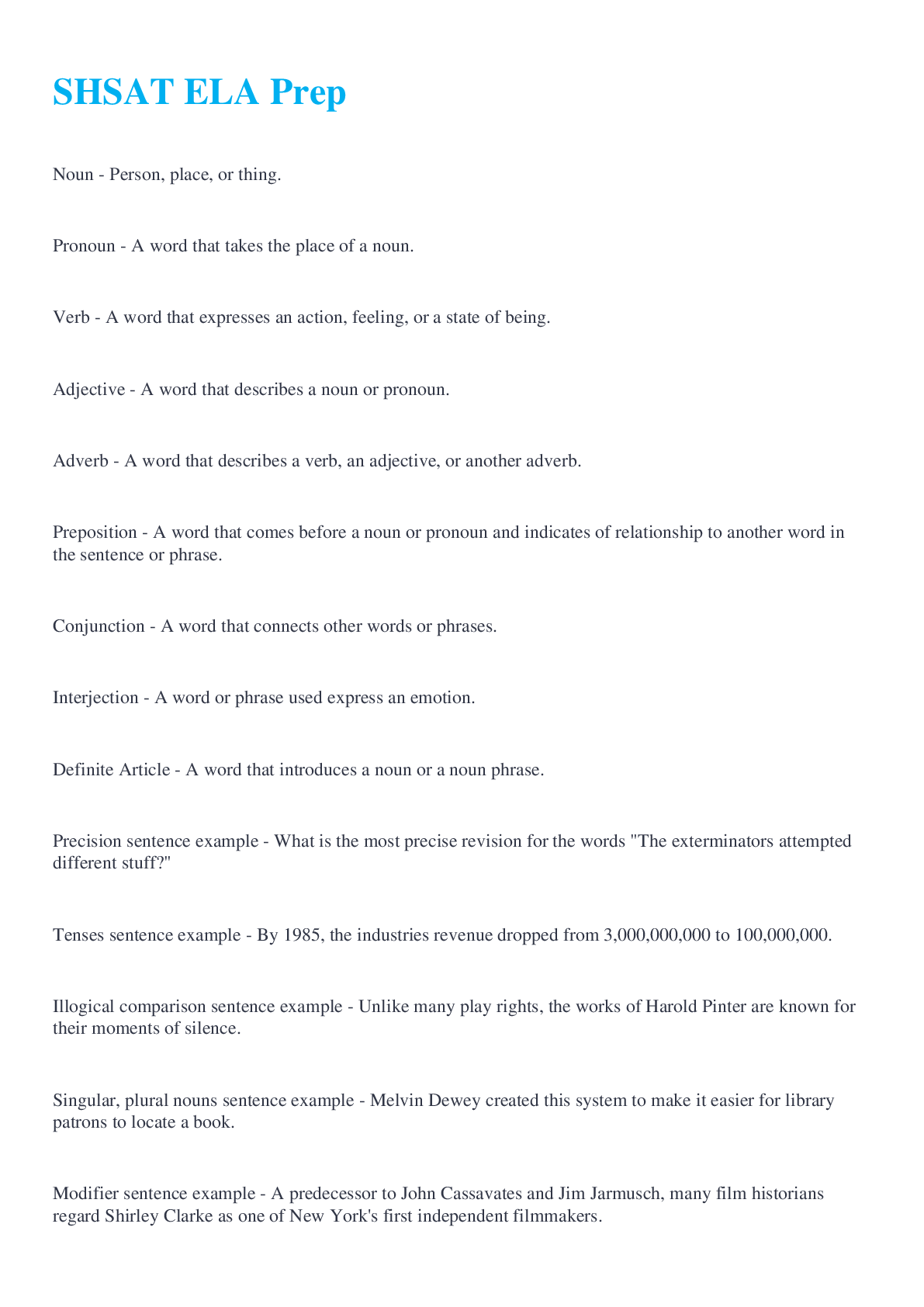

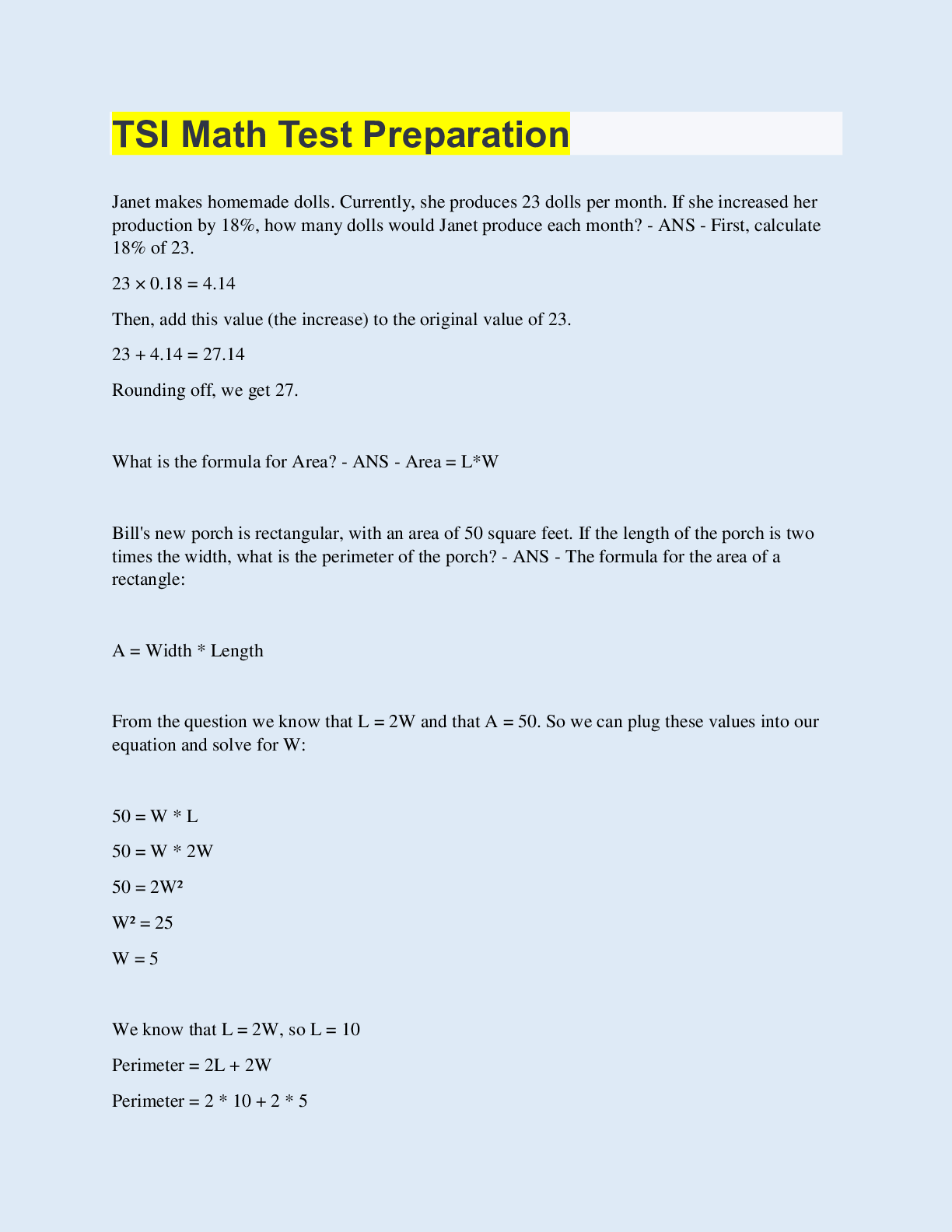
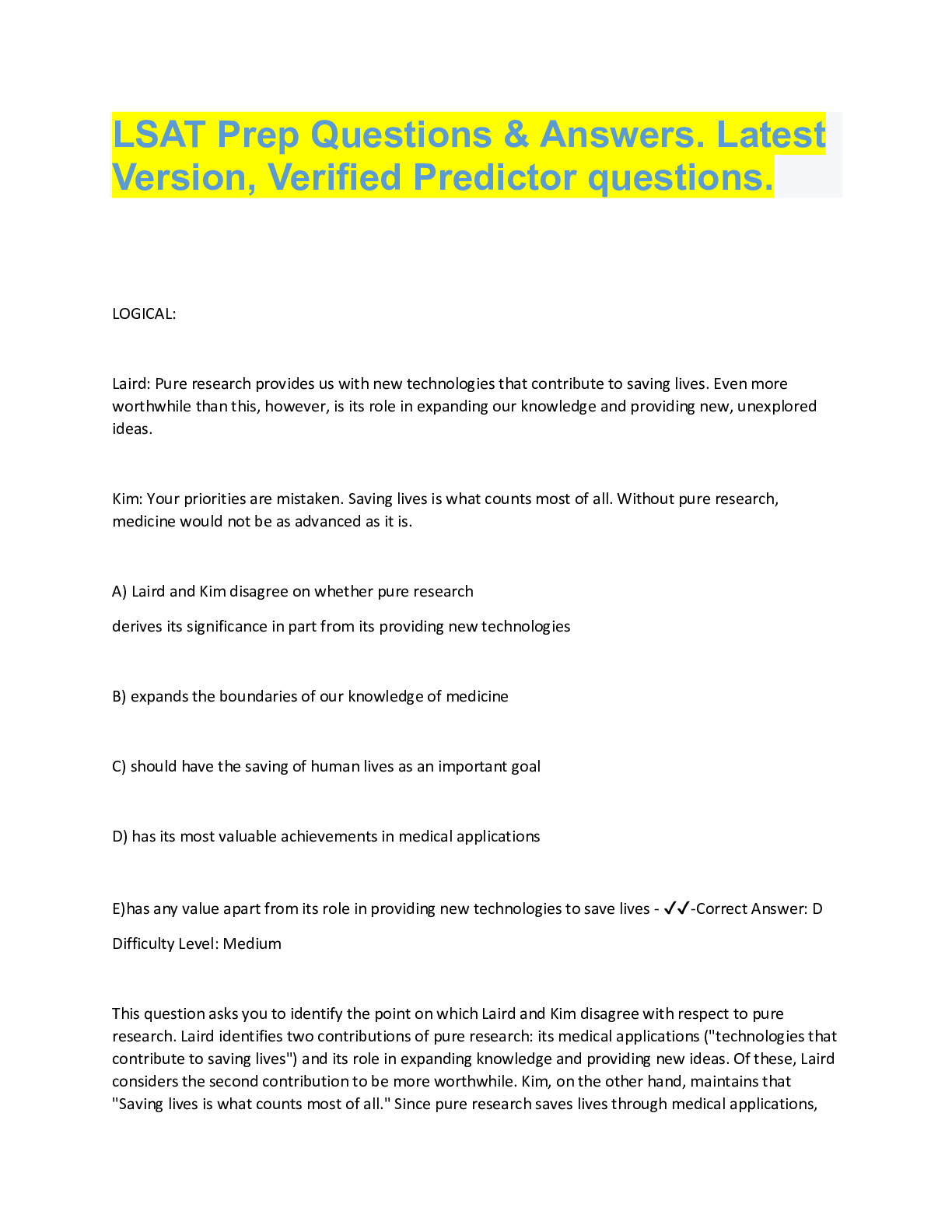
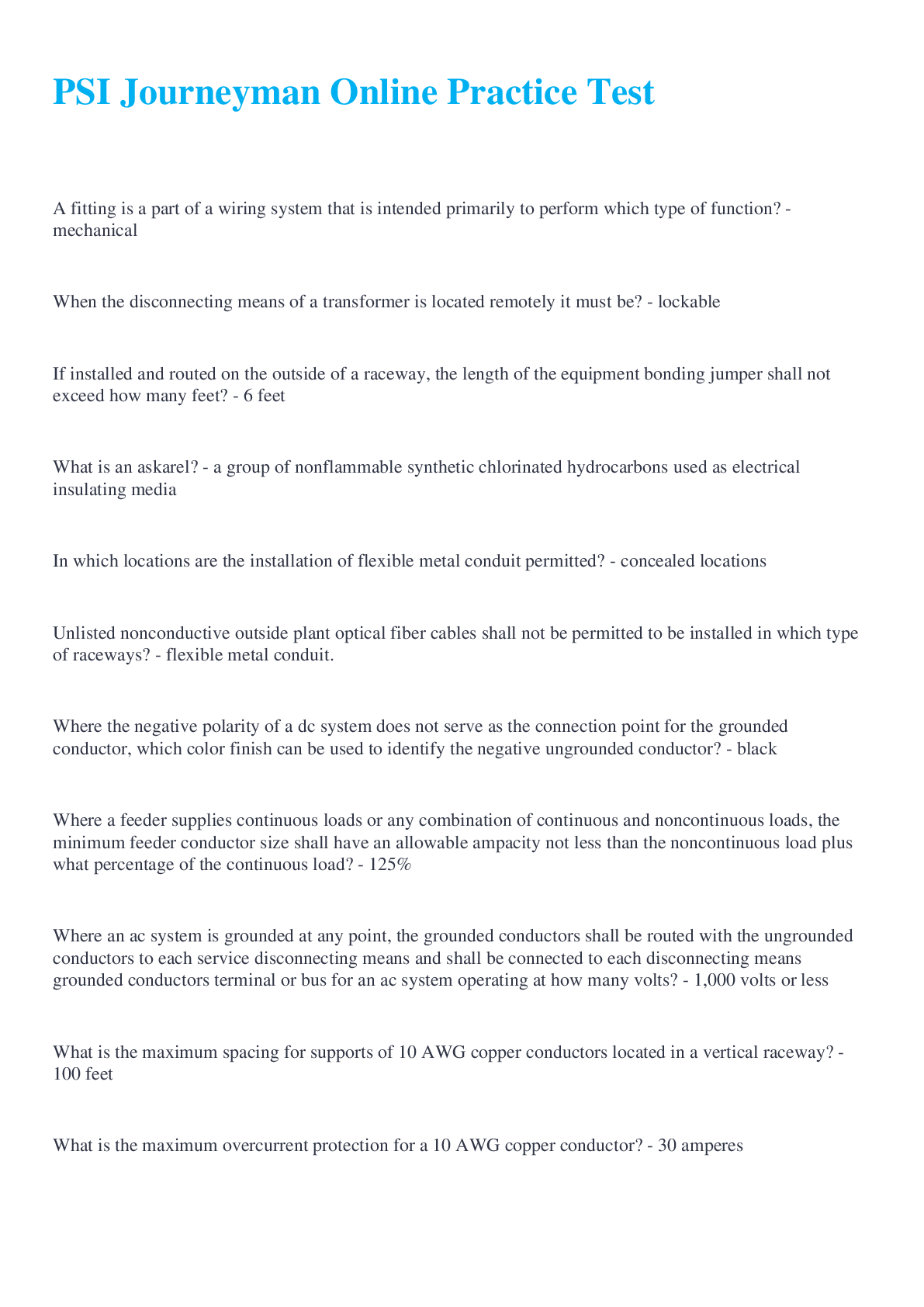
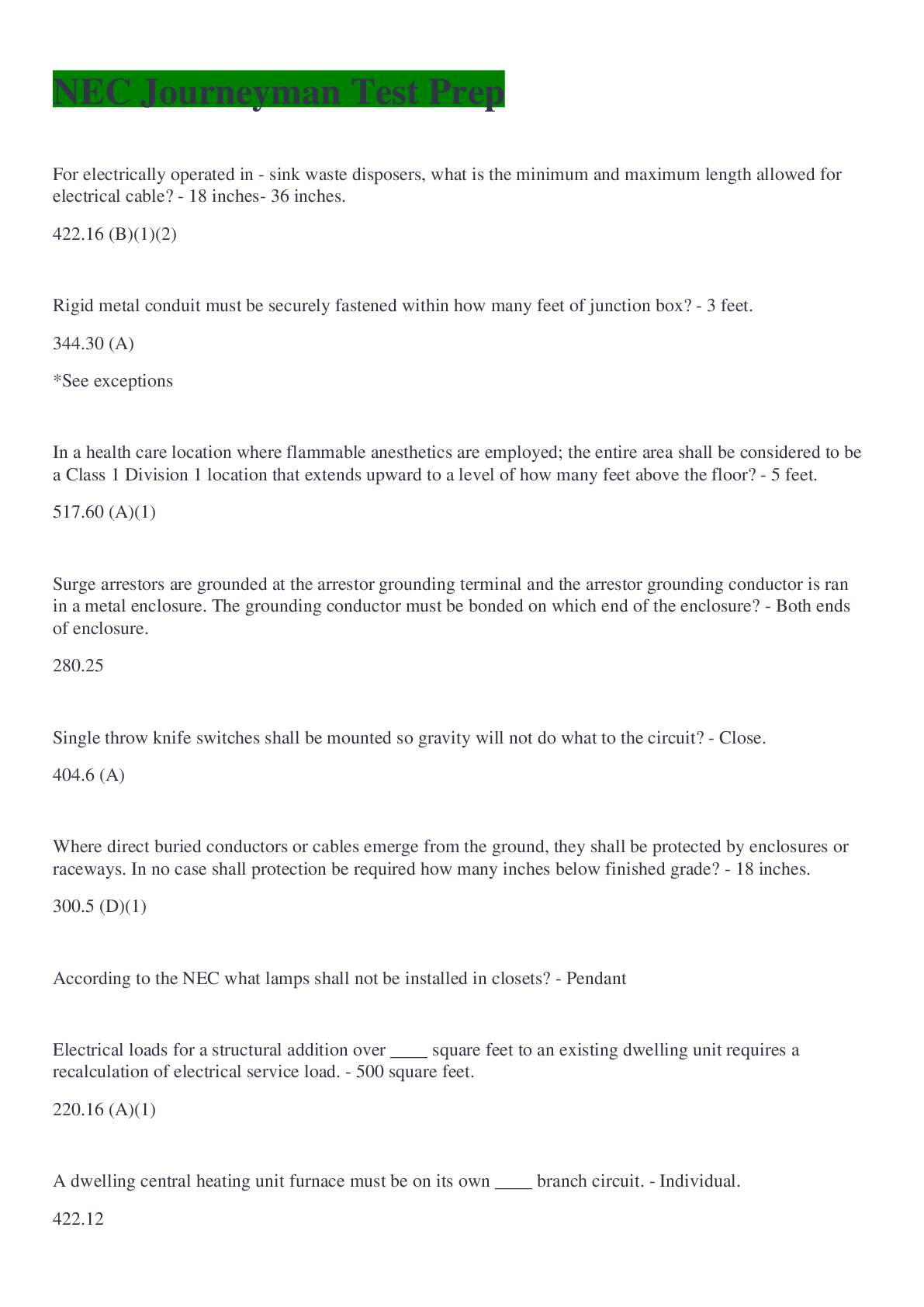
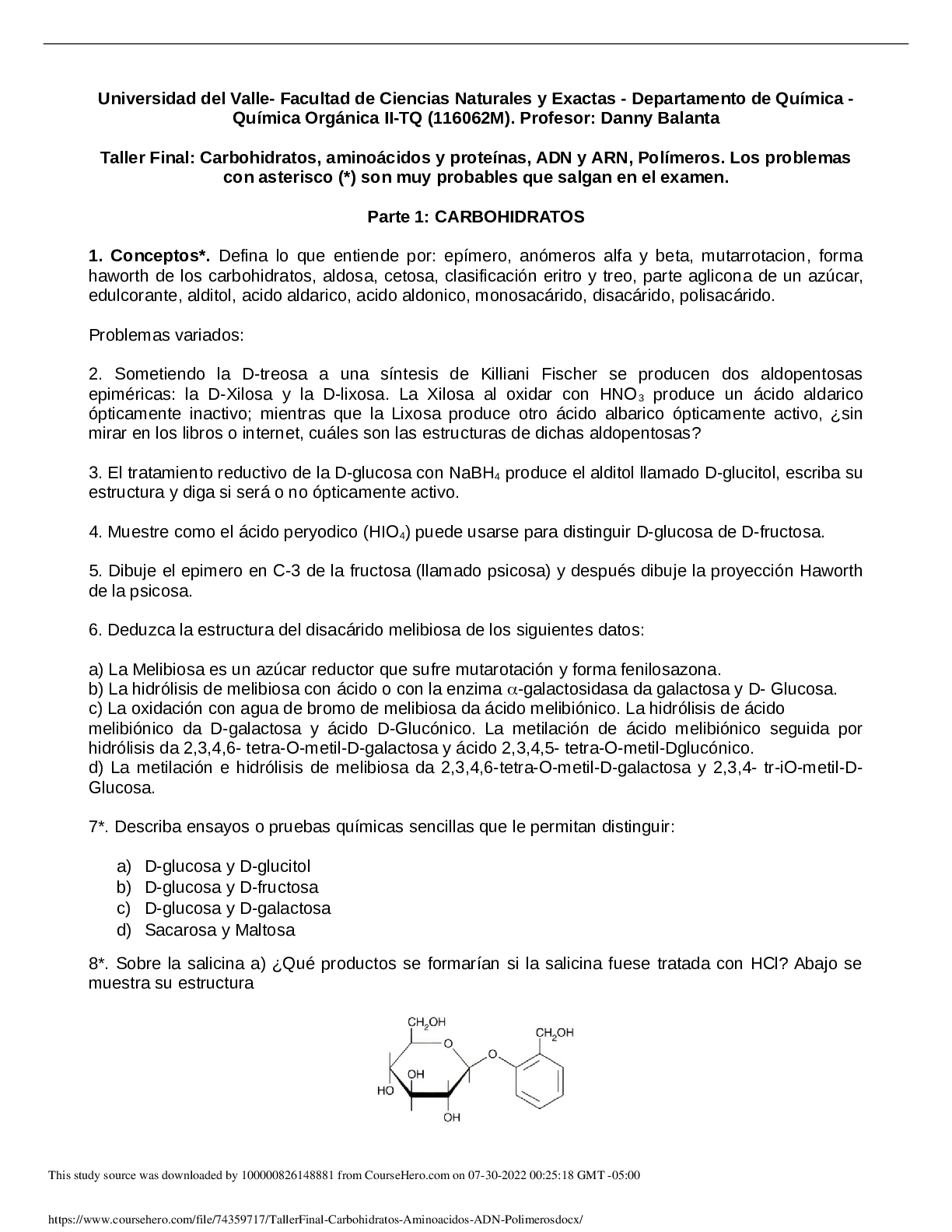
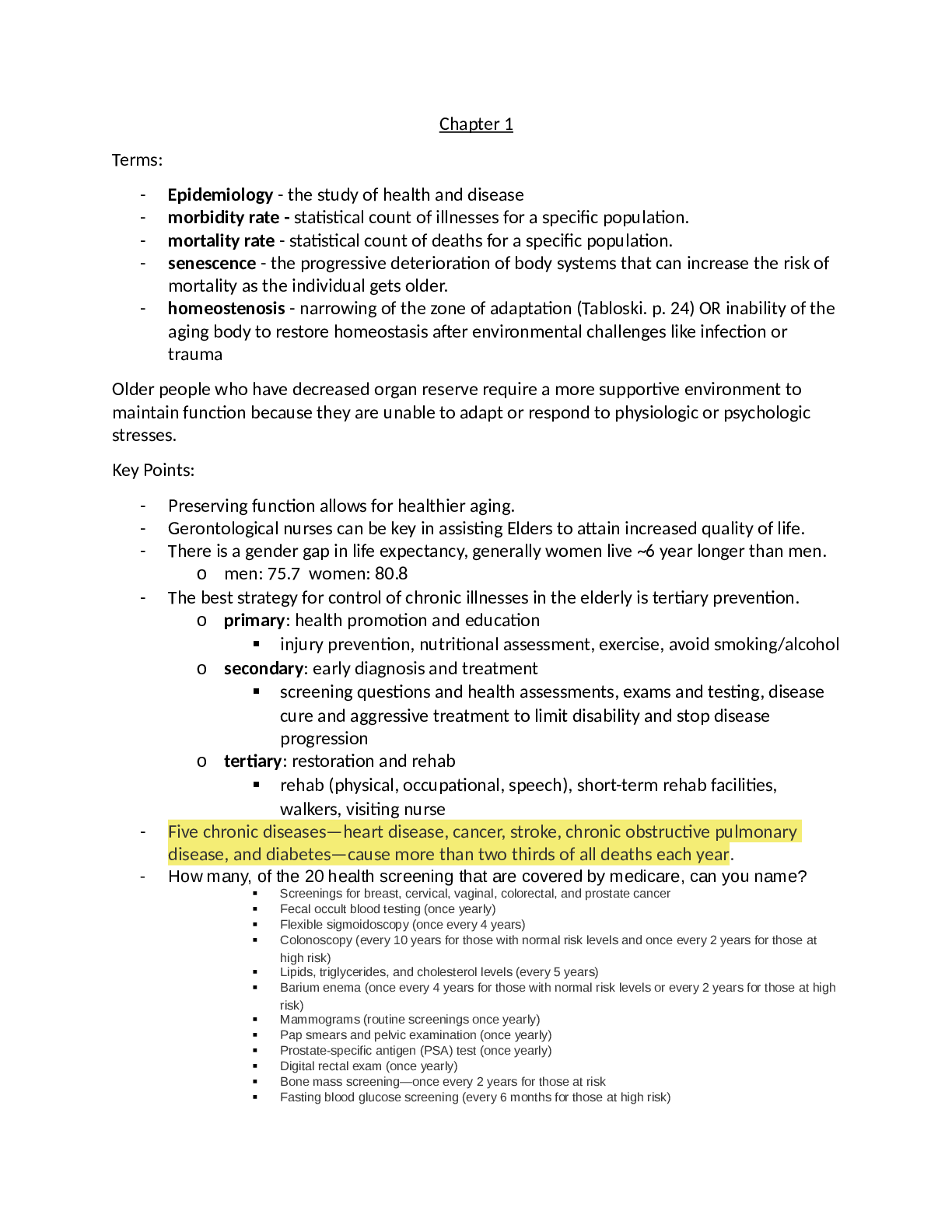

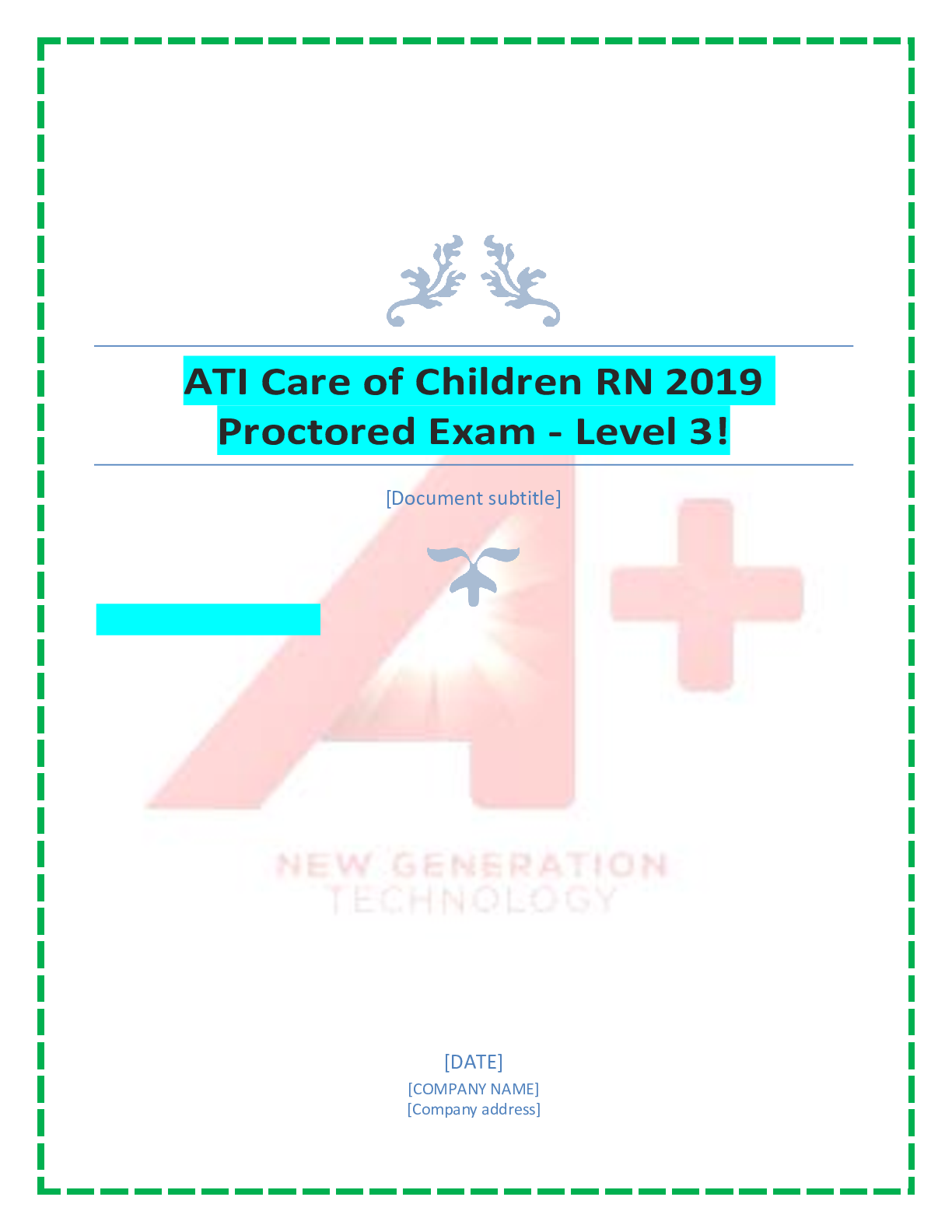
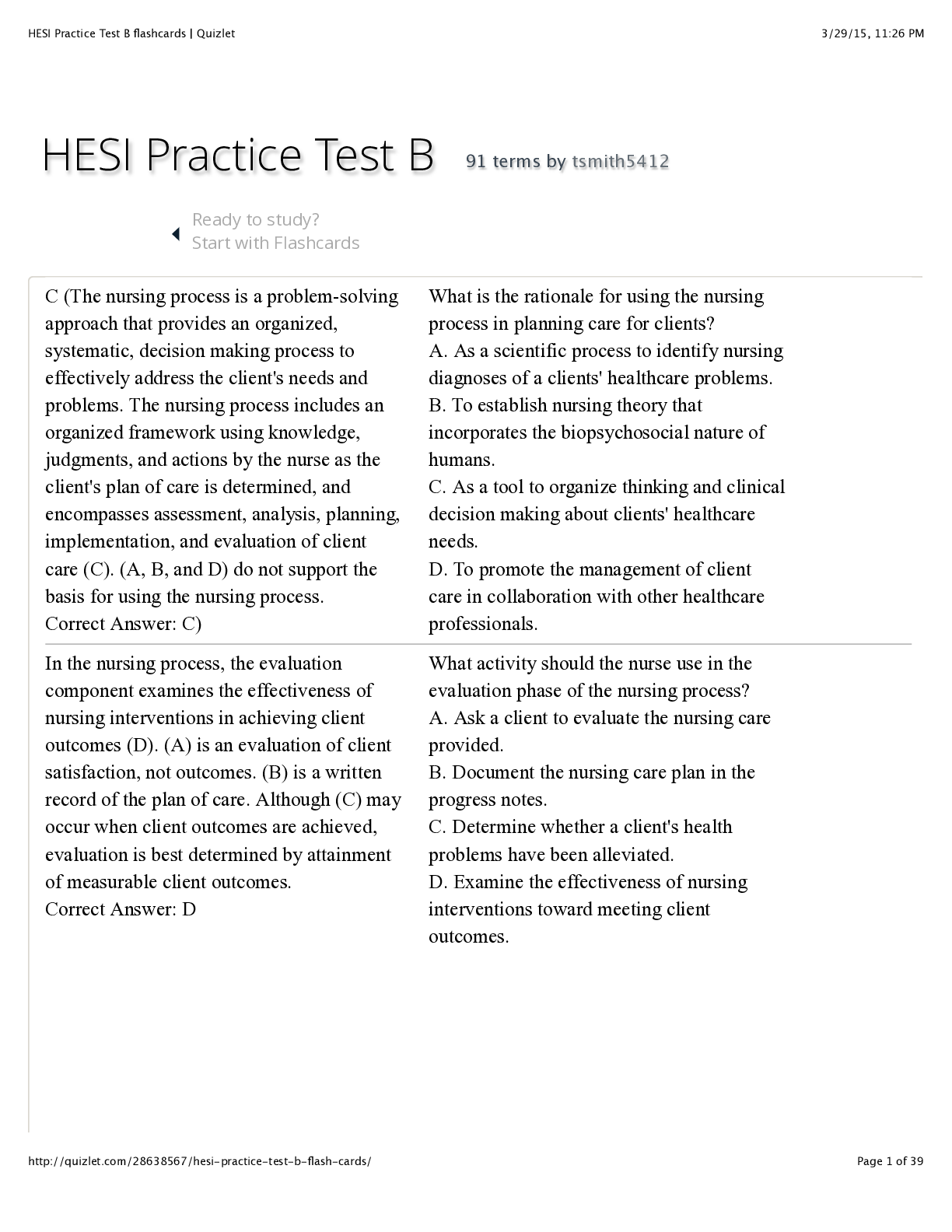
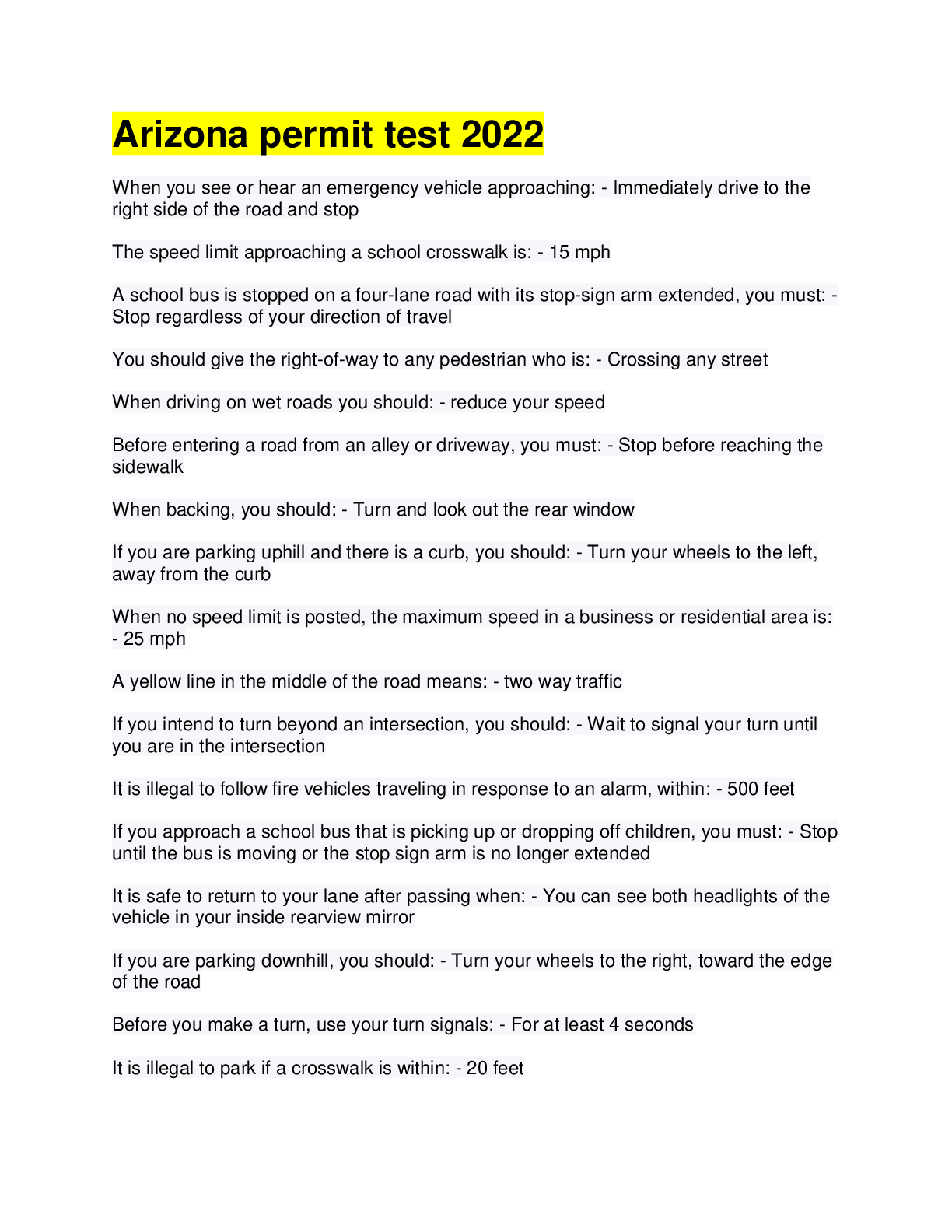

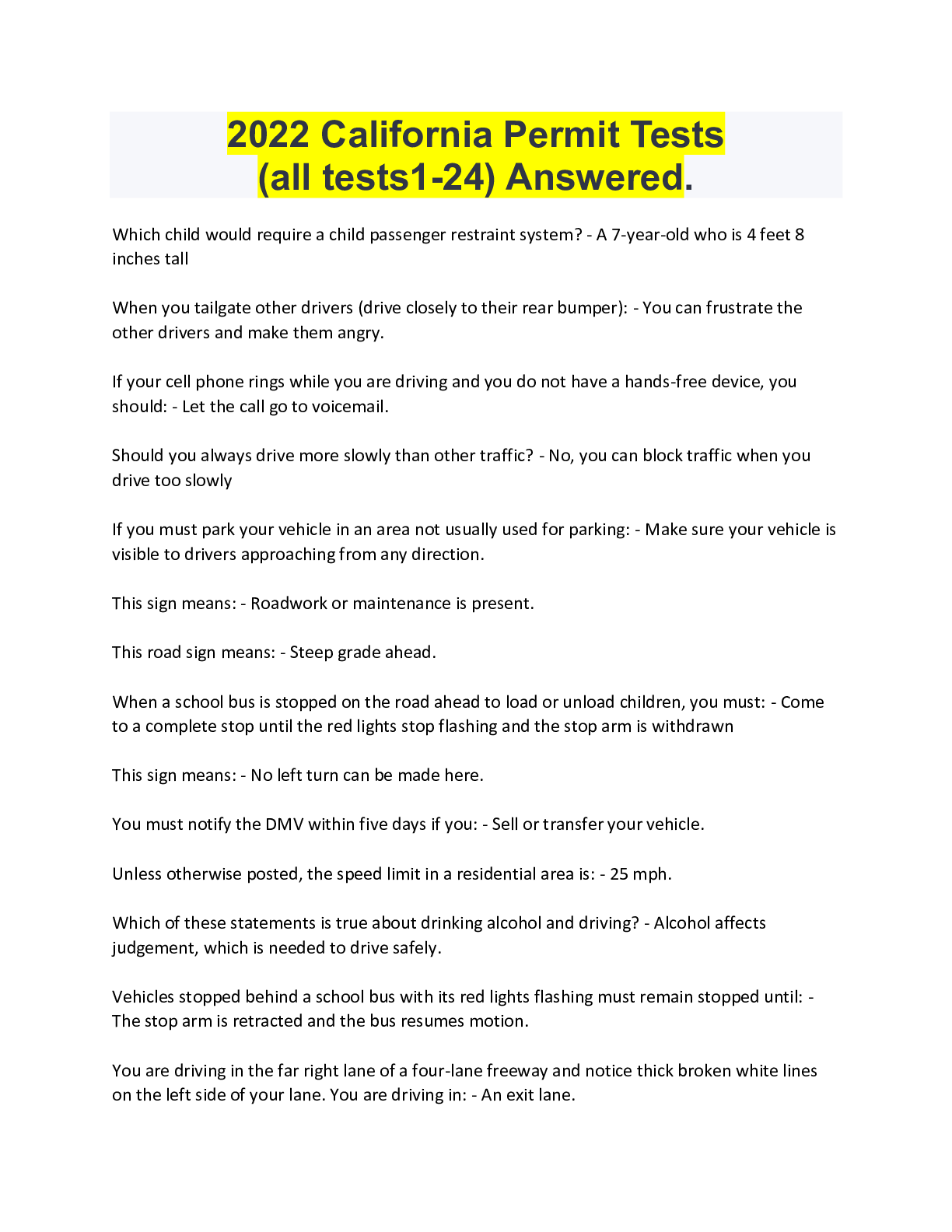
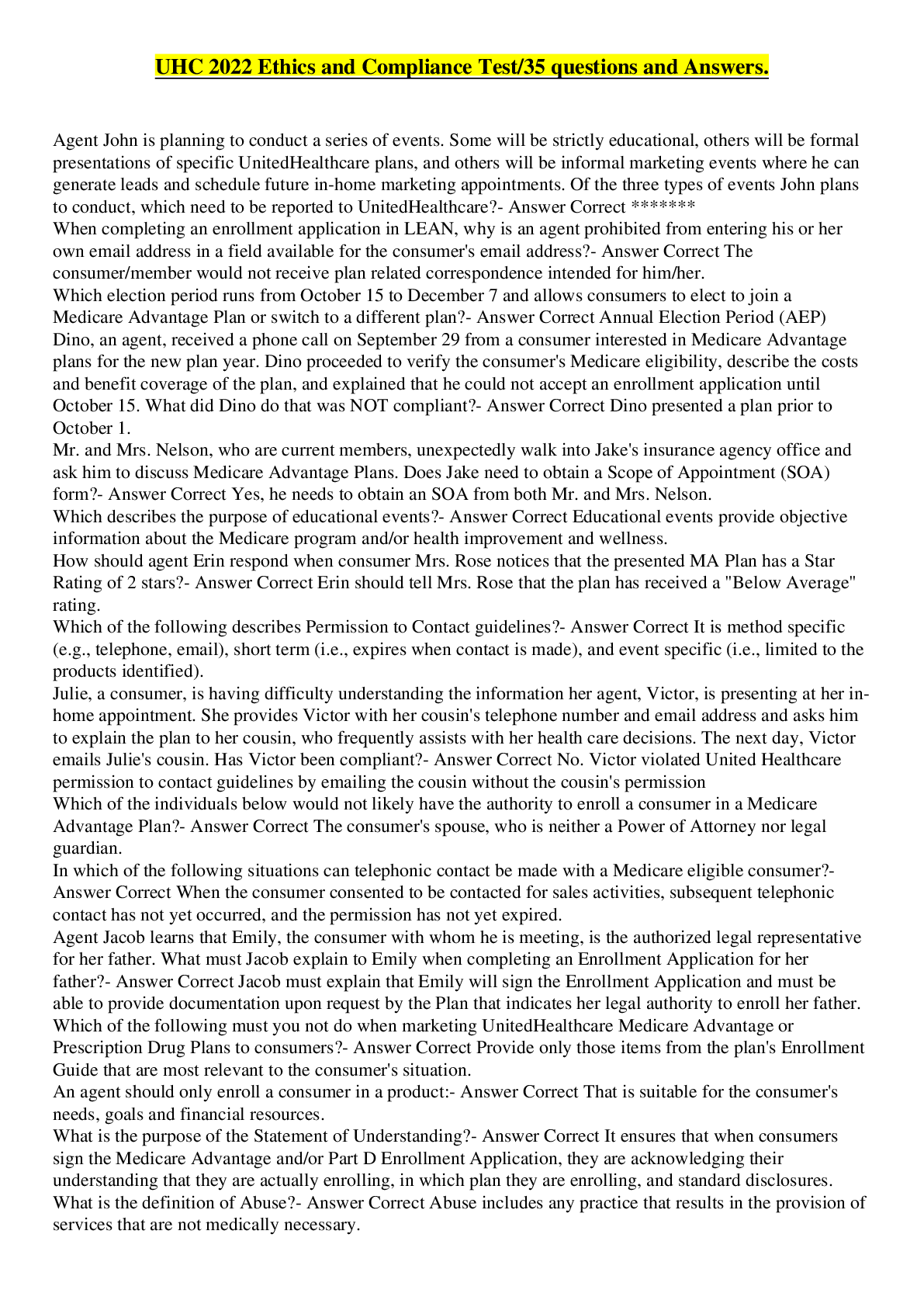
.png)
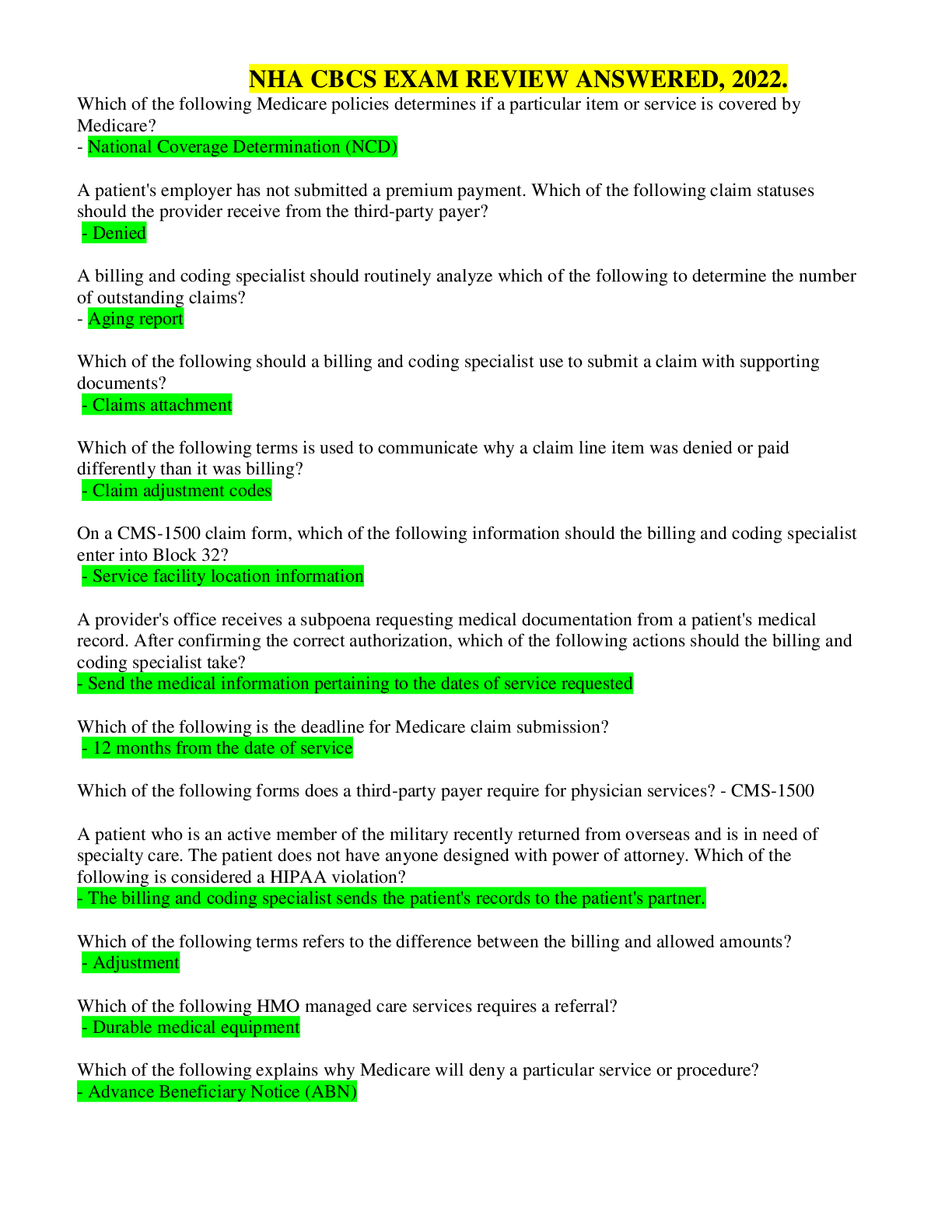
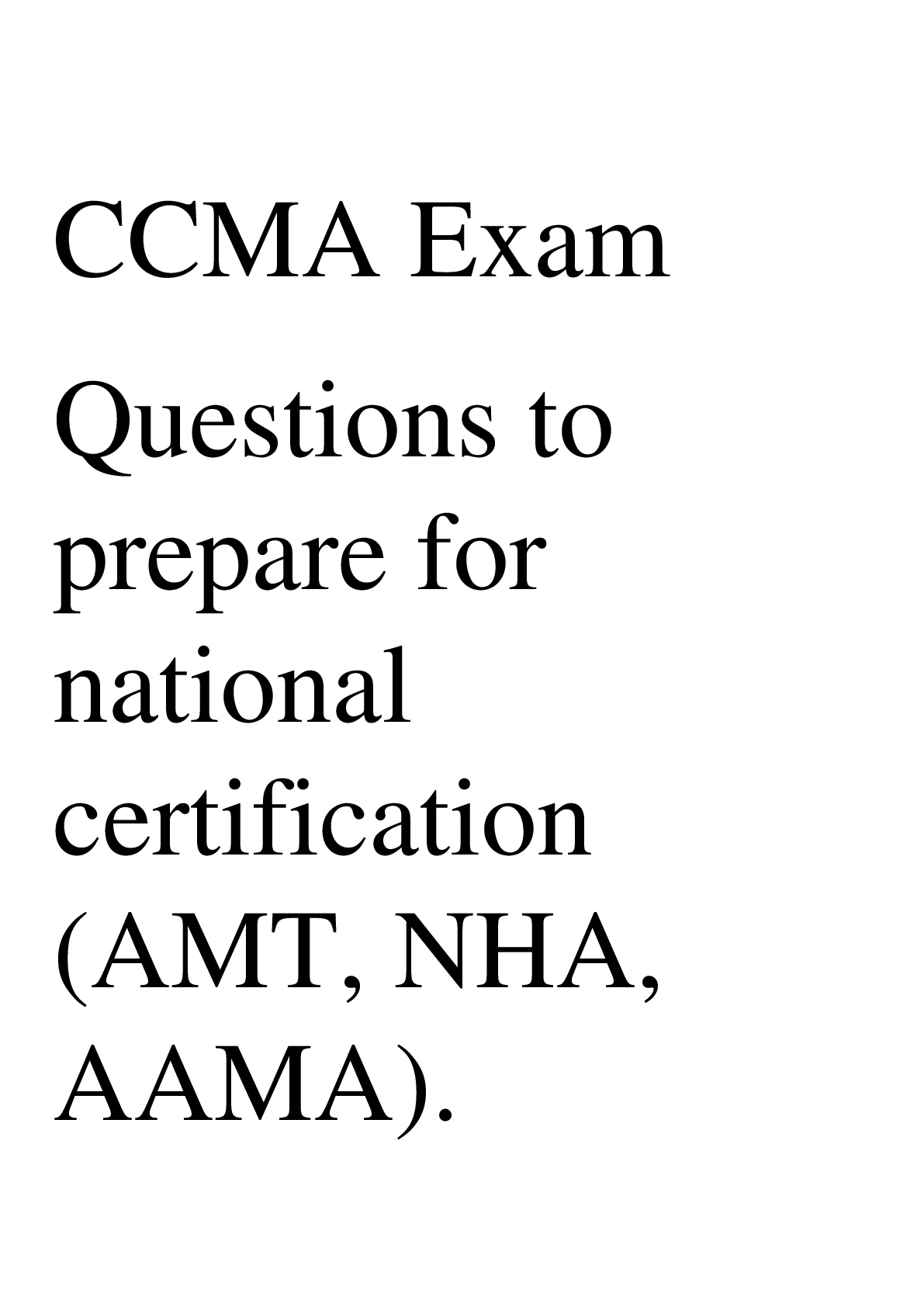

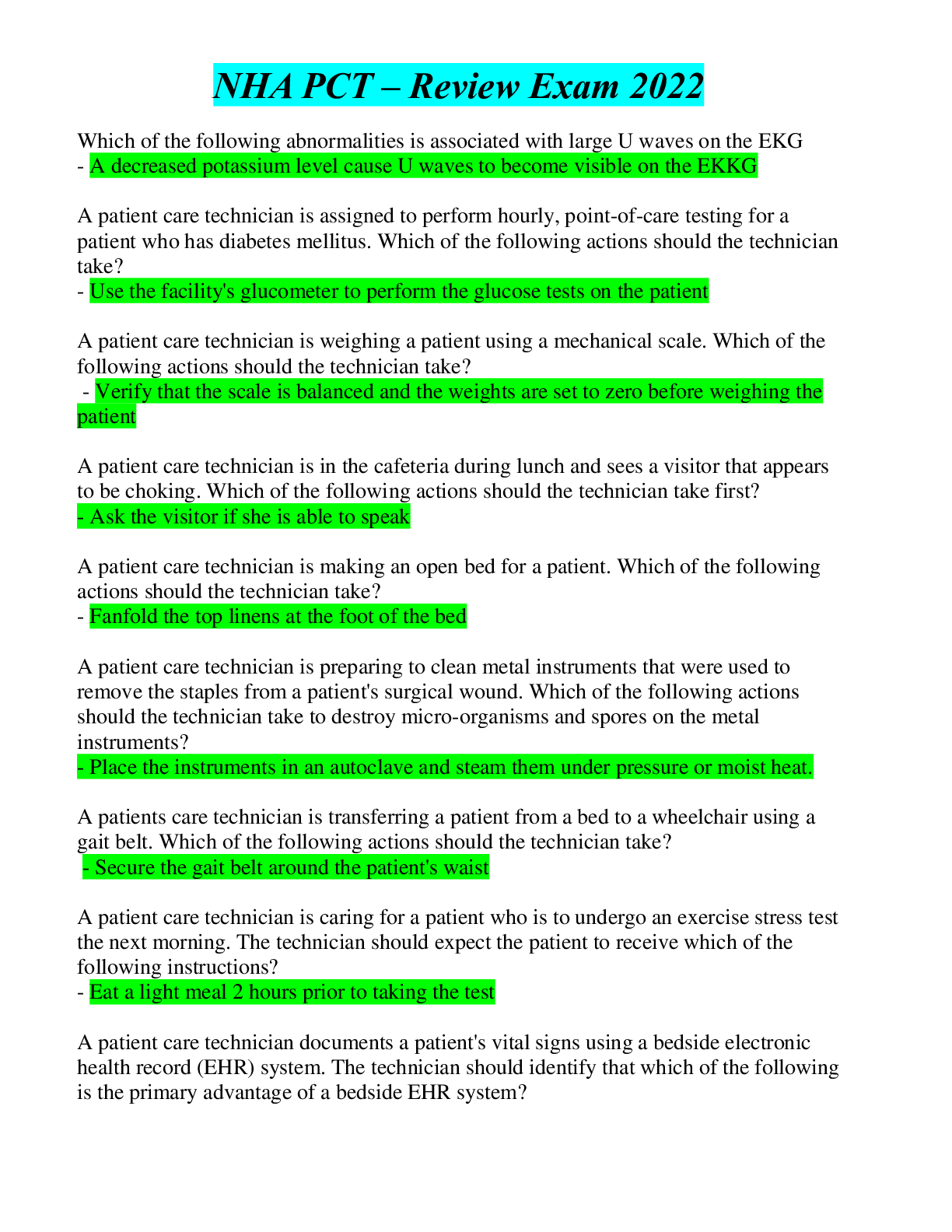
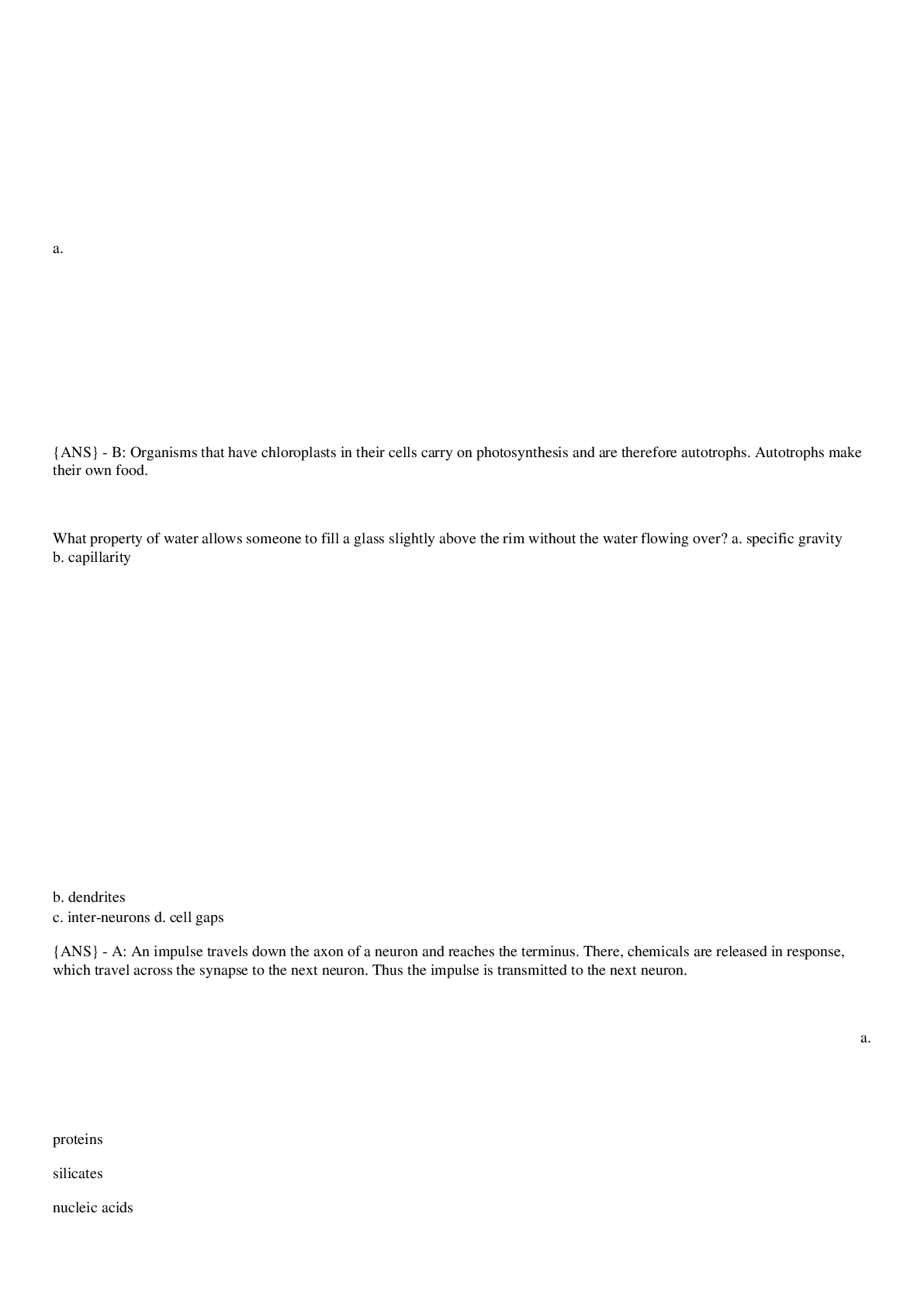

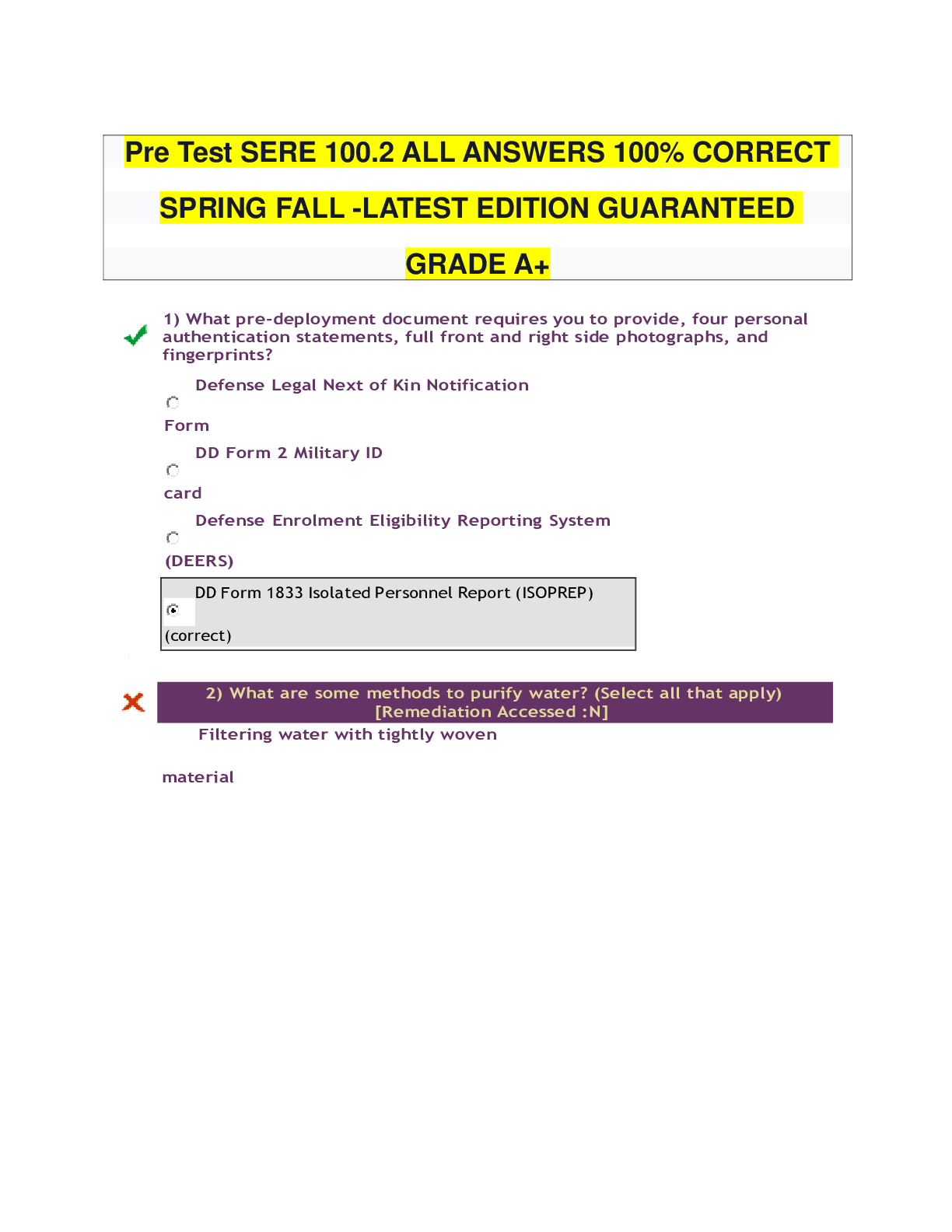
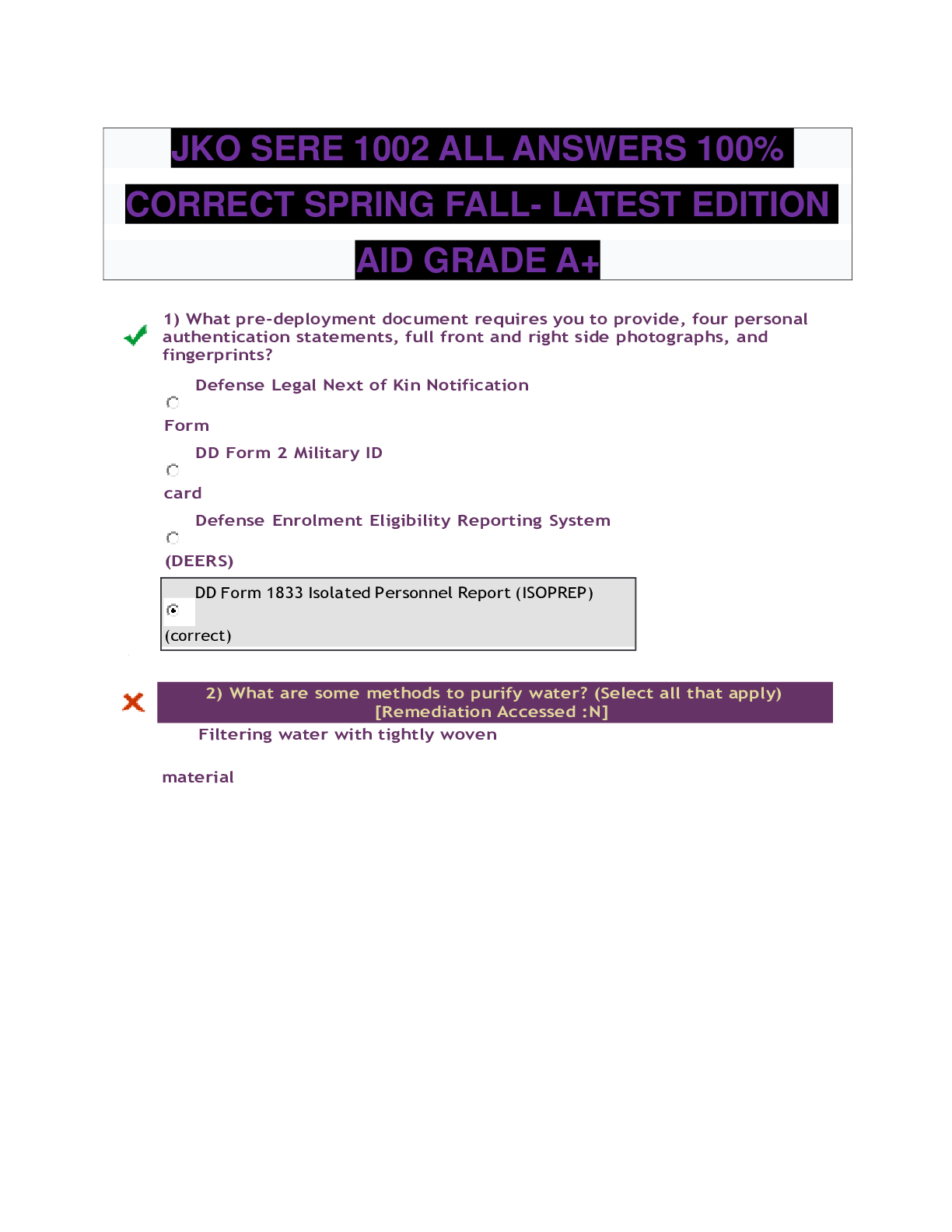
.png)
